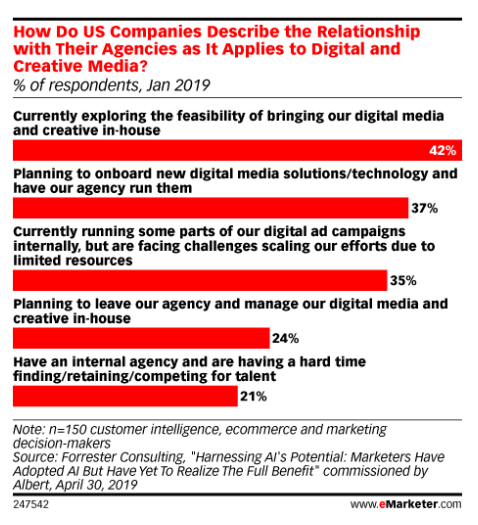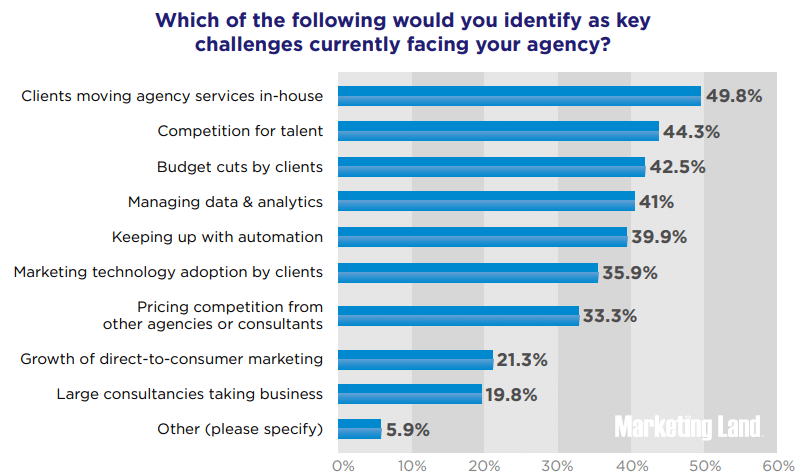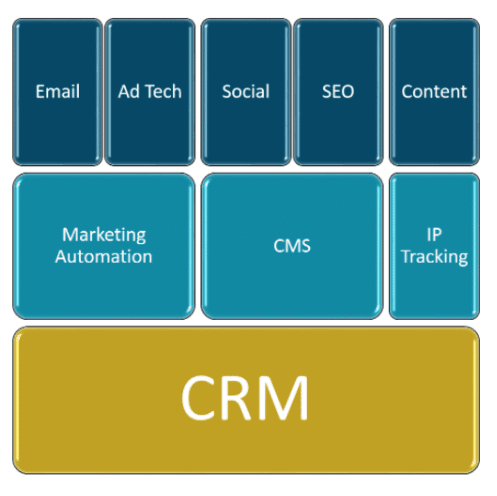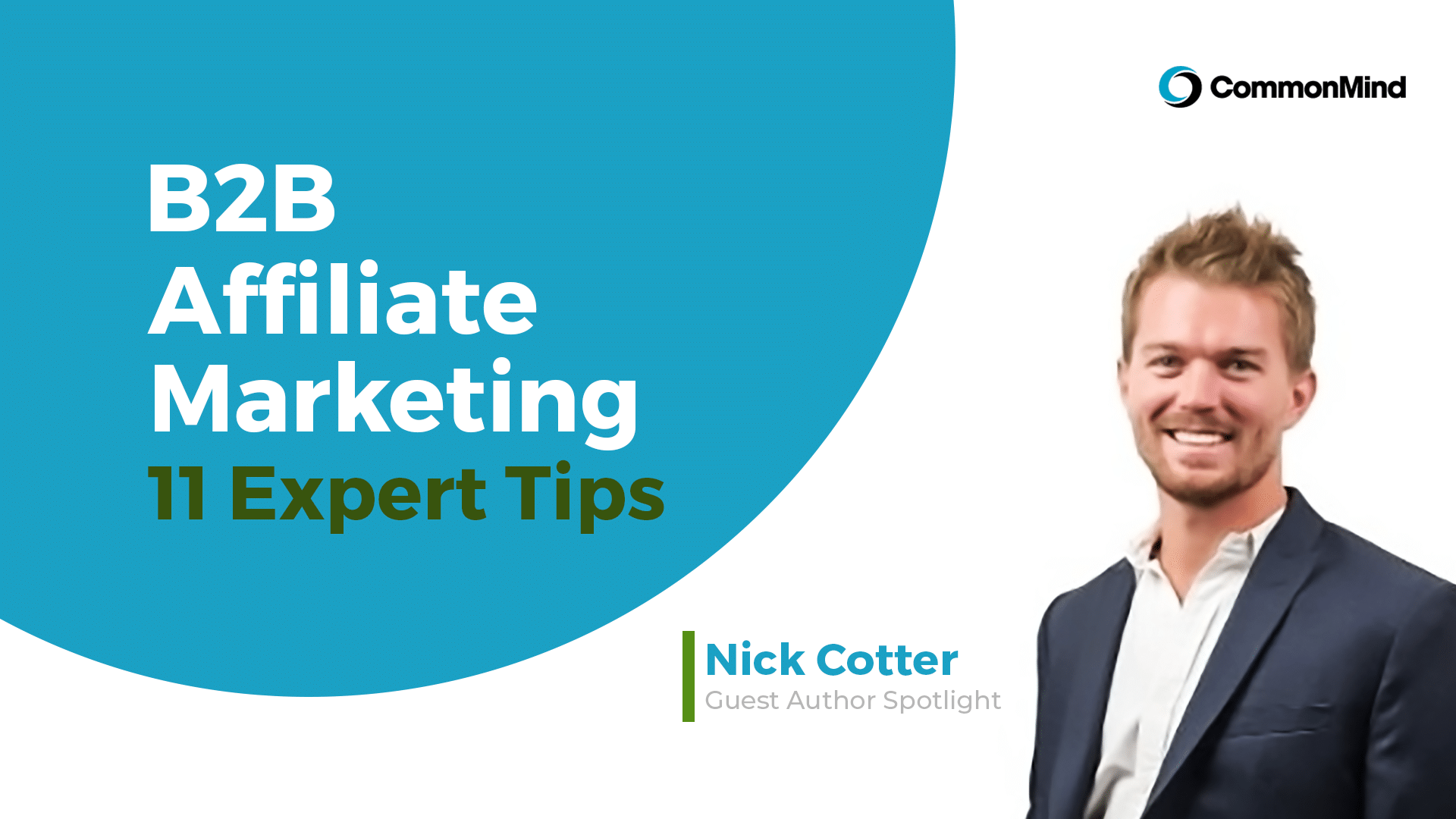Agency vs. In-house, What Are Companies Choosing and Why?

Advertising agencies have been around for over two centuries, with Volney B. Palmer opening the first US agency in Philadelphia in 1843. Since then, the advertising and marketing industries have grown and changed to such an extent that they’re nearly unrecognizable compared with what they were just a few decades ago. New channels, mediums, and technologies have created a host of opportunities—and challenges—for brands and agencies alike.
One key element of advertising that remains constant is that the role of the agency is perpetually changing—often rapidly and unpredictably. In the B2B space, for example, the alignment of sales and marketing teams has emerged over the past decade as a key driver of change. This approach requires a massive shift in the dynamic between how companies operate internally and it touches every aspect of business growth, down to the ad creative itself.
Regardless of whether you focus on the B2B or B2C sector (or both), a question that inevitably arises for many businesses is, what drives the marketing best? Should you outsource a given task or service, assign it to an existing in-house resource, or bring in new talent to address a particular need or area of expertise?
Broadly speaking, the answer to this question is…it depends.
The current state of agency/company relationships
A Forrester 2019 survey of 150 ecommerce and marketing decision makers revealed that 42% of respondents were currently exploring bringing digital media and creative services in-house. However, nearly 40% of respondents also planned to onboard new digital media or technology solutions and have their agency run them.
This hybrid approach is not uncommon, with 35% of respondents indicating they are running some parts of their digital ad campaigns internally, but face challenges scaling efforts due to limited resources. The following eMarketer chart illustrates the complete range of results, which involves a variety of agency relationships from bringing all digital media and creative functions in house, to outsourcing, to taking a hybrid approach.

The report revealed that client-side marketers want more agility from their agencies, which is unsurprising given the constantly changing advertising landscape. This is particularly true now, in an age where many businesses are struggling to address the unprecedented challenges presented by the coronavirus. It’s increasingly important for agencies to listen to what clients are saying and rise to the occasion of providing services and support in creative, adaptive new ways.
In-housing versus out-sourcing
The growth of data-driven marketing has upended the way companies approach traditional agency services. In a 2019 Marketing Land survey of 900 agency representatives, just under half indicated that they felt clients moving agency services in-house was a top challenge, followed only by competition for talent.

Other agency pain points that can lead to clients pulling work include the inability or agencies to find talent, budget cuts by clients, managing data & automation, and keeping up with automation.
It’s clear that there’s no single issue that contributes to in-sourcing, but many factors are contributing to this phenomenon.
So, in this new age of big data, AI-driven marketing & sales, emerging technology, budget restrictions (though this one is hardly new) and the wildcard that is COVID-19, is there still a role for agencies? We think so.
The role of the agency partner
Marketing agencies can still play a powerful role in enabling businesses to achieve growth and meet their goals. To do this, agencies, like the clients we work with, need to adapt to the changing needs of businesses—and this requires flexibility. Here are a few examples of different ways that agencies and their clients can work together to support and drive marketing initiatives.
Vendor management and review
While the agency-of-record model still exists, it can be expensive and (let’s face it), it’s rare that you find a single agency, vendor, or platform that meets all of your needs, let alone understands your specific business sector. But if you have a trusted agency that you’ve been working with for one, two, or twelve years, a great way to leverage that relationship is to pull on them for vendor management and review.
A good example of this is in managing your tech stack which is comprised of a variety of different solutions that may include ad tools and tech, marketing automation, your CMS, and your CRM. Per Smart Insights, a typical B2B tech stack looks something like this:

Your agency likely has experience with a variety of martech and adtech tools across dozens, even hundreds, of clients. This puts them in a great position to help guide you through the buying process for a new solution or tool.
Likewise, agencies with IT, SEO, and web design expertise can help facilitate the integration and onboarding of a new tool in the event that you don’t have enough staff on hand to manage what can often be a lengthy and complex process.
Vendor management and review need not be limited to technology recommendations. Your trusted agency partner can help you review other agencies and RFPs, as needed, and help with the process of ongoing vendor management if you don’t have the resources or expertise to manage these multiple moving parts internally.
Management of specialized tasks and projects
As mentioned above, the new agency/client model needs to be flexible. Long term and costly retainers might not make sense for all but the largest of businesses. Instead, shorter term (e.g., 3-6 months) or even month-to-month retainers versus 12-month commitments offer more flexibility in a constantly changing marketing environment.
The approach to pricing is particularly relevant with one-off projects or tasks. A flexible agency need not charge a flat retainer for a fixed amount of months, but nevertheless be available for you when you don’t have the resources on staff to complete a specialized task, urgent project, or solve a critical problem (e.g., updating your website to comply with GDPR, migrating to a new CRM or sales platform, creating and launching a time-sensitive campaign, etc.)
Agencies have resources and expertise that are specifically suited to a host of digital marketing and creative projects, so don’t discount them when you have an urgent need, particularly if you don’t have the resources in-house to address it. Falling behind can be more costly than hiring an outside resource when you need the help, which brings us to our final point.
The ripple effect of falling behind
One of the top benefits of working with an agency is to avoid falling behind on much-needed (and time consuming) projects such as content management, website development/updates, social media management, SEO, and more.
Falling behind on one key component of marketing tends to ripple through an organization, creating lasting issues such as poor search engine rankings, subpar customer experience, and reduced revenue.
An agency partner can help to mitigate and resolve issues before they snowball, then fall back to the sidelines until they’re needed again. This hybrid approach to the agency/client relationship is a best-of-both worlds strategy that ensures you’re staying competitive, keeping up with technology, providing top notch customer experiences, and meeting achieving your revenue and growth goals consistently.
***
Contact us to learn more about our B2B-focused digital marketing services which include SEO, paid search, social media, content creation and more. We’re happy to provide a free 30-minute consultation.
Share this
You May Also Like
These Related Stories

11 Expert Tips on Launching a Successful B2B Affiliate Marketing Program

The Importance of Content Ideation for B2B Marketers
